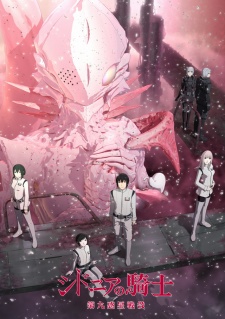
If there's any difference between the two seasons of Knights of Sidonia released up to this point, it would be that Battle for Planet Nine is a harem sandwiched by hard sci-fi on both ends. When the original Sidonia began we were already on board Sidonia, floating through space with some of the last remaining remnants of humanity, and quickly we were forced to adapt to the bizarre futuristic setting and its many small details about biology, technology, and physics, all while being tripped up by a 3D style of animation that is rarely if ever seen in anime nowadays. Watching Battle for Planet Nine, I found the 3D style to be the source of a curious phenomenon I hadn’t thought about while watching Sidonia: while most people find it off-putting to the point of undermining the experience of the show, I had to consciously block out my enjoyment of it to realize that the second season was following all the classic anime tropes of romantic comedy. Say what you will, but it has been a long time since a sci-fi felt so futuristic, and that starts right from the animation.
As Sidonia started in the middle of humanity’s repetitious schedule of bitterly fighting for survival, they aren’t in a much better spot at the start of Battle for Planet Nine, which picks up right where the first season stopped. The red Benisuzume, born from the cells of Nagate’s dead lover Hoshijiro, has escaped from the reaches of Sidonia, and their contact brought about many casualties, as well as a renewed drive to develop weaponry to end the plague of Gauna from the universe once and for all. In Sidonia, the name “Ochiai” slipped into the whispers of many characters almost the way a swear word comes up in a circle of young children, where everyone can tell through sheer intuition that something is wrong even as it passes through their lips. He clearly shared the newfound enthusiasm of the ragged Sidonia crew, but he also took it too far, to the point where he was eradicated not by the Gauna he sought to kill, but by the humans he sought to protect. His chance finally comes one hundred years later, as the disgraced and all-but-forgotten Kunato siblings fall under the control of his wayward personality, right as the curtains come up on Battle for Planet Nine. An episode later, a Gauna named Tsumugi appears under the banner of humanity’s ally, his first project in the new era.
People seem to doubt Tsumugi’s intentions, but after six or seven episodes of a few scarce fights punctuating the love-comedy that plays out between her, Nagate, and Nagate’s old friend Izana, involving the development of sex characteristics, oddly phallic talking tentacles, and eventually a single house for all three to live, we couldn’t possibly think of her as dangerous to humanity, although she is dangerous to the integrity of the Sidonia series as a futuristic survival science fiction tale. We stay mostly within the comfortable bounds of Sidonia itself, with some political maneuvering, weapons development, and a touch of drama mixed with enough slapstick to play it off. The heralded battle for Planet Nine itself shows up with just three episodes left to go, and while there are some truly inspired touches regarding the planet’s constitution, wildlife, and Gauna population, the fight generally plays out in a very straightforward way, save for one character we may have forgotten at this late stage. It is a fun fight to watch, complete with the desolate atmosphere and technological detail we can expect from Sidonia and full use of the animation style. But at no point was it truly more special than anything routine fight we have seen humanity face again and again and again.
I remember many moments in the original Sidonia that felt like an incredible use of the setting and characters to create a human drama while remaining completely focused outside Sidonia’s walls. Hoshijiro and Nagato trapped in space, only slightly beyond the boundaries of having enough fuel to make it back, and thus being forced to use that fuel in an attempt to survive long enough to be saved. Seeing the massive Sidonia being torn apart internally from the stress of making just a slight turn to avoid destruction, as houses fly into the air and casualties grow. Nagate heading triumphantly into battle, and suddenly the camera cuts to him in a hospital bed, confused and unaware that he had allowed the one he loved to die until it shows up on his TV. His yearning for her as he wasted day after day watching a Gauna placenta grow in her form in a glass box, vainly hoping she would once again come into his arms.
Even in Battle for Planet Nine the Gauna are very much an external threat, not understood by humans in any way, and who’s motives are irrelevant. Through experimentation and manipulation they begin to learn about the way in which the Gauna fight, but even the addition of a Gauna soldier to their ranks does not give them an ounce of sympathy for the alien menace they struggle against, and that is exactly how it should be. The warped sense of rigid social structure, the captivating landscape of their artificial home; all the elements are still there, and I can say that I enjoyed it in the same way I enjoyed Sidonia. But some small piece of Sidonia’s commanding presence is lost. It told a completely foreign story without being bogged down in unnecessary explanations while still revealing dozens of details; battles of survival for one person felt as desperate as the battles for humanity’s existence. The harem focus just wasn’t a good choice.